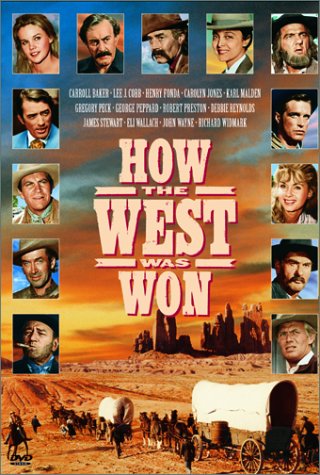
How The West Was Won
|
It took $15 million, three
directors, 23 stars and co-stars, more than 12,000 extras, 77 sets, 1200
bison, 875 horses, 500 steer, 200 sheep, 160 mules and 50 oxen to make
this 1963 Cinerama extravaganza. The focus of the film is the Prescott
family who are searching for the "promise" land in the wild
west. It is ironic that the final scene in the movie is an airborne shot
of heavy traffic on the Hollywood Freeway! Nowadays such a shot
recalls the adventures of OJ Simpson rather than the success of the
pioneering spirit of early settlers. If one can set aside the loss of
confidence in American omnipotence that the later years of the Sixties
produced, and snuggle into a large chair with a huge bowl of popcorn and
cast "politically correct" notions aside for a few hours, then
you are in for a treat. The biggest stars of the early Sixties perform
admirably despite the difficulties posed by the Cinerama cameras that
required close-ups to be shot from only 18 inches from the actor's head!
It is delightful to see James Stewart play a fur trapper named Linus
Rawlings and win over the heart of Carroll Baker who plays Eve Prescott.
Eve's sister , Lillith (Debbie Reynolds) falls in love with a slick
gambler and opportunist named Cleve Van Valen (Gregory Peck). One is
entertained by the marvelous performances of Lee J. Cobb (Marshall
Lou Ramsey), Henry Fonda ( Jethro Stuart), Karl Malden (Zebulon Prescott),
George Peppard (Zeb Rawlings) and other stars too numerous to mention.
The Cinerama technique involved using 3 cameras and
seven-channel stereophonic sound, but only a dozen theatres were ever able
to show the movie in all its glory. In the DVD version, two vertical lines
- where film from the cameras join - are clearly visible. But once
you get used to that distraction and concentrate on the action, the movie
moves along at a lively pace. The best scenes are wonders to behold:
hundreds of buffalo stampeding through the white man's campsite at the
urging of Indians who felt betrayed by the arrival of thousands of
settlers, and the spectacular gunfight on a moving train. The
musical score of Alfred Newman, which incorporates folk tunes with
symphonic overtures, is brilliant. Indeed the music provides soul and
unity to the different sequences directed by Henry Hathaway, George
Marshall and John Ford. Yes indeed, this film is a product of
"another time, before the self-doubt and introspection of the last
quarter of the 20th century became predominant. Nowadays, the moviegoer is
not likely to feel goose bumps of nationalistic pride as the conquest
of the west unfolds, but rather troubled nostalgia for a time so free of
doubt.
|
|
